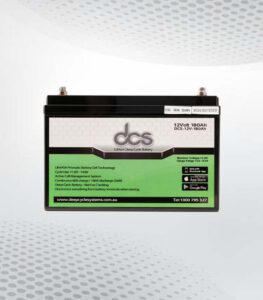
Why choose a 200Ah Deep Cycle Battery for Long-lasting Performance? Regarding energy storage, the 200Ah deep cycle battery stands out for its robust performance and reliability. This powerhouse of energy storage offers a remarkable blend of longevity, cost-effectiveness, and versatility, making it an excellent choice for various applications. But what exactly makes a 200Ah deep cycle battery so special, and why should you consider investing in one for your energy needs? Let’s dive into the details.
Understanding the Basics of Deep Cycle Batteries
Deep cycle batteries are engineered to discharge and recharge repeatedly, providing a steady power flow over extended periods. This characteristic distinguishes them from starter batteries, designed for short bursts of high power. The term “200Ah” represents the battery’s capacity, indicating it can supply 200 amperes of current for one hour or a different rate over a different period, such as 100 amperes for two hours. This flexibility in power delivery is crucial for applications that require consistent energy over long durations.
Deep cycle batteries achieve this through a design that allows them to be deeply discharged, up to 80% or more of their capacity, without significant damage. This feature sets them apart from other battery types, which may suffer from decreased lifespan under similar conditions. This ability to withstand deep discharges makes them an ideal choice for systems that depend on reliable power availability over longer periods, underscoring their importance in energy storage applications.
The Cost-Effectiveness of Investing in a 200ah deep cycle
Investing in a 200ah deep cycle might seem like a significant upfront expense, but its true value lies in its long-term benefits. These batteries’ robust construction and deep discharge capability mean they are less susceptible to wear and tear, translating into a longer lifespan than standard batteries. This extended service life dramatically reduces the frequency of replacements, which results in considerable savings over time when combined with minimal maintenance requirements.
Moreover, their reliability in delivering consistent power minimizes downtime in various applications, further enhancing their cost-effectiveness. The ability to sustain deep discharges with minimal impact on their overall health ensures that users get the most out of every charge cycle, optimizing the energy cost per unit over the battery’s life.
Therefore, while the initial investment may be higher, the efficiency and durability of a 200Ah deep cycle battery provide unmatched value, making it a financially savvy choice for anyone looking to maximize their energy storage solution.
Applications That Benefit Most from a Battery Deep Cycle 200ah
A Battery Deep Cycle 200ah is exceptionally versatile, catering to various settings that demand continuous and reliable power. In off-grid solar systems, these batteries are pivotal, storing energy harnessed from the sun during the day to power homes and facilities through the night. For enthusiasts of the open road and sea, recreational vehicles and marine vessels rely on these batteries for everything from lighting to powering essential navigation systems without needing constant recharging.
Backup power systems, particularly in areas prone to power outages, also gain significantly from the substantial energy reserve a 200Ah battery provides, ensuring operations remain uninterrupted.
Additionally, these batteries are increasingly becoming a choice for sustainable living practices, including powering remote cabins or for use in eco-friendly projects where reducing carbon footprints is a priority. The reliability and capacity to endure repeated deep discharge cycles without compromising performance make the 200Ah deep cycle battery a cornerstone for energy resilience in these applications.
Comparing 200ah Battery Deep Cycle with Other Battery Types
When evaluating 200ah Battery Deep Cycle against other battery options, a nuanced understanding of their distinctions is imperative. Lithium-ion variants, celebrated for their lightweight and high energy density, entail a substantially higher cost, potentially making them less accessible for budget-conscious consumers.
On the other hand, conventional lead-acid starter batteries, although initially more affordable, need more endurance and resilience when subjected to frequent and deep discharges. This deficiency significantly impacts their practicality for applications demanding sustained power over prolonged periods. AGM (Absorbed Glass Mat) and Gel batteries, cousins in the lead-acid family, offer maintenance requirements and leakage prevention improvements but still do not match the deep cycle batteries’ ability to endure repeated deep discharges without substantial performance degradation.
In applications where reliability over extensive discharge cycles is paramount, the 200Ah deep cycle battery emerges as the clear frontrunner, blending cost-efficiency with durable, long-term energy provision. This comparison underscores the critical importance of assessing the initial purchase price, the long-term operational costs, and compatibility with specific energy needs when choosing between battery types.
Maintenance Tips for Maximizing the Life of Your 200 Amp Hour Deep Cycle Battery
Adherence to a regular maintenance routine is essential to extend the lifespan and ensure optimal performance of your 200 Amp Hour Deep Cycle Battery. Keep a vigilant eye on the battery’s charge state; it’s critical to avoid allowing it to fall into a state of deep discharge beyond its recommended level or remain overcharged, as both extremes can degrade its longevity.
Ensure the battery terminals remain clean, dry, and free from corrosion by periodically checking and cleaning them with baking soda and water, followed by a rinse with clean water. Tightening loose connections is also advisable to maintain efficient power flow. Storage conditions play a significant role in preserving battery health; thus, it should be kept in a cool and dry location to prevent exposure to extreme temperatures and moisture, which can accelerate wear.
By integrating these maintenance practices into your routine, you safeguard the health of your 200Ah deep cycle battery, fostering sustained performance over its intended service life.
Environmental Impact and Sustainability of Deep Cycle Batteries
Deep cycle batteries, particularly when considering the widely used lead-acid type, present environmental challenges primarily due to the toxicity of lead and the acid used in these batteries.
However, the industry has made significant strides in addressing these issues, with a robust recycling infrastructure now in place. Lead-acid batteries are among the most recycled products globally, with a recycling rate of over 95% in North America. This high recyclability significantly diminishes the environmental footprint associated with their use, as it ensures that most battery components are reused rather than disposed of in landfills.
Moreover, manufacturers increasingly focus on sustainable practices throughout the production process, from responsibly sourcing materials to implementing more energy-efficient manufacturing techniques.
Additionally, advancements in battery technology are gradually reducing the reliance on hazardous materials, paving the way for more environmentally friendly alternatives. It’s also worth noting that the extended lifespan and the ability to endure numerous discharge-recharge cycles without significant degradation make 200Ah deep cycle batteries more sustainable, as they require less frequent replacement than batteries with shorter service lives.
How to Choose the Right 12v 200ah Deep Cycle Battery for Your Needs
When selecting a 12v 200ah Deep Cycle Battery, evaluate your energy consumption patterns to determine the capacity and discharge rate suitable for your requirements. Consider the environment where the battery will operate, as temperature extremes can influence performance. Evaluate the dimensions and weight to ensure compatibility with your installation space.
Assess the type of deep cycle battery—whether AGM, Gel, or Lithium-ion—based on your specific needs, such as maintenance preference and budget constraints—research manufacturers to identify those with reputable track records for producing durable and reliable batteries.
Additionally, scrutinize warranty offerings, as they can provide insights into the manufacturer’s confidence in their product’s longevity and performance.
Consult with professionals if you’re uncertain about the technical specifications that best align with your usage scenarios. Lastly, consider the environmental impact of your choice, opting for batteries with sustainable manufacturing processes and recycling programs. By carefully weighing these factors, you can choose a 200Ah deep cycle battery that effectively meets your energy storage needs.
The Future of Energy Storage and the Role of 200Ah Deep Cycle Batteries
In the advancing landscape of energy solutions, 200Ah deep cycle batteries emerge as pivotal components in bridging the gap between current energy demands and future sustainability goals. Their capability to provide stable, long-duration power supply positions them as integral parts of renewable energy systems, particularly in solar and wind power setups where energy availability can fluctuate.
As we lean more into the decentralization of energy networks, these batteries are becoming indispensable in creating resilient micro grids that can operate independently or in conjunction with the main power grid, enhancing energy security and reliability across communities. Innovations in battery technology continue to enhance their efficiency and environmental friendliness, ensuring that 200Ah deep cycle batteries remain at the forefront of the shift towards greener, more sustainable energy storage solutions. Their role is not just confined to bridging energy gaps but also to facilitating the broader adoption of renewable energy sources by making energy storage more reliable and accessible, thereby accelerating the transition to a future where clean, renewable energy powers our daily lives.
Optimizing Performance: Tips for Getting the Most out of your 200Ah Deep Cycle Battery
Maximizing the efficiency and lifespan of your 200Ah deep cycle battery requires a blend of proper charging practices and vigilant care. Ensure a compatible charger matches the battery’s specifications, avoiding under or overcharging, which can shorten its life.
Implementing a regular charging schedule based on usage rather than waiting for the battery to deplete fully can also help maintain its health. Investing in a quality solar charge controller or battery management system is advisable, as these devices can prevent damage from overcharging and ensure that the battery remains within its optimal charge parameters.
Additionally, periodic checks for clean and secure connections prevent power loss and potential corrosion, while storing the battery in a cool, dry environment protects it from temperature extremes that can affect performance. By adhering to these practices, you can significantly enhance the functional longevity and efficiency of your 200Ah deep cycle battery, ensuring that it delivers the best performance throughout its service life.
FAQs
Q: Can a 200Ah deep cycle battery be used in any weather?
A: While 200Ah deep cycle batteries are robust, extreme temperatures can impact their performance and lifespan. It’s best to protect them from extreme cold and heat where possible.
Q: How often should a 200Ah deep cycle battery be replaced?
A: The lifespan varies based on usage, maintenance, and charging practices. Typically, these batteries can last 4-8 years with proper care.
Q: Can I use a 200Ah deep cycle battery for my solar panel system?
A: Absolutely. These batteries are ideal for solar energy storage because they can handle deep discharges and store substantial amounts of power.
Q: Is it necessary to fully discharge a 200Ah deep cycle battery before recharging?
A: No, it’s better to avoid deep discharges when possible. Regular, partial discharges with consistent recharging are preferred to maintain battery health.
Q: How can I tell if my 200Ah deep cycle battery is failing?
A: Signs of failure include a significant drop in performance, inability to hold a charge or visible damage to the battery case. Regular testing can help identify potential issues early.
Conclusion
In wrapping up, the 200Ah deep cycle battery embodies an exceptional blend of endurance, economic efficiency, and adaptability, distinguishing it as a prime selection for a broad spectrum of energy storage applications. Embracing insights into its operation, the principles of diligent maintenance, and the criteria for making an informed selection can empower users to harness the full potential of these batteries. With an eye towards sustainability and the evolving landscape of energy needs, the 200Ah deep cycle battery is poised to facilitate the transition to more renewable and reliable energy solutions. Ensuring that you engage with these batteries thoughtfully will optimize their performance and contribute to a more sustainable and energy-efficient future.











